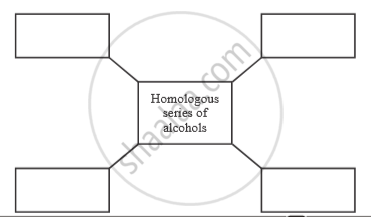Advertisements
Advertisements
प्रश्न
As one ascends in any homologous series, physical properties change gradually.
पर्याय
Right
Wrong
उत्तर
As one ascends in any homologous series, physical properties change gradually- Right
APPEARS IN
संबंधित प्रश्न
What is a homologous series?
Write the name and formula of the 2nd member of homologous series having general formula CnH2n.
Write the molecular formula of the 2nd and 3rd member of the homologous series where the first member is ethyne.
Fill in the following blank with suitable word:
Carbon compounds have usually ... melting points and boiling points because they are ...... in nature.
The number of carbon atoms present in the molecule of fifth member of the homologous series of alkynes is:
(a) four
(b) five
(c) six
(d) seven
The molecular formula of the third member of the homologous series of ketones is:
(a) C4H8O
(b) C3H6O
(c) C5H10O
(d) C6H12O
Give the abbreviated formula of the third member of the alcohol.
Distinguish between homologous organs and analogous organs. In which category would you place wings of a bird and wings of a bat? Justify your answer giving a suitable reason.
Write names of first four homologous series of alcohols.

Give the names of the first four members of the homologous series of
alkynes.
While going in an increasing order there is a rise in the molecular mass of the consecutive members of the homologous series by _______.
The general molecular formula for the homologous series of alkynes is _______.
Write a short note.
Homologous series
Which of the following does not belong to the same homologous series?
Name the following organic compound:
The first homologue whose general formula is CnH2n.
A carbon compound ‘A’ having melting point 156K and boiling point 351K, with molecular formula C2H6O is soluble in water in all proportions.
- Identify ‘A’ and draw its electron dot structure.
- Give the molecular formulae of any two homologues of ‘A’.
Write the chemical formula of two consecutive homologous of organic compounds having functional group - OH.
What happens to the (i) boiling point and (ii) solubility of organic compounds of a homologous series as the molecular mass increases?
Consider the following molecular formulae of carbon compounds:
(i) CH3COOH (ii) CH3OH (iii) C2H6 (iv) C3H4 (v) C4H8
- Which one of these compounds belongs to homologous series of alcohols?
- Identify the compound having triple bond between carbon-carbon atoms.
- Write the molecular formula of the first member of the homologous series to which CH3COOH belongs.
- Write the general formula of the series to which the compound C4H8 belongs.
Consider the carbon compounds having following molecular formula:
(i) C3H6 (ii) C3H8 (iii) C4H6 (iv) C6H6 (v) C6H12
- State the number of double covalent bonds present in C3H8.
- Write the formula of first member of the homologous series to which the carbon compound C4H6 belongs.
- Which one of the above compounds forms a ring structure of carbon atoms?
- Identify, which of the above compounds, is a member of alkane series.
